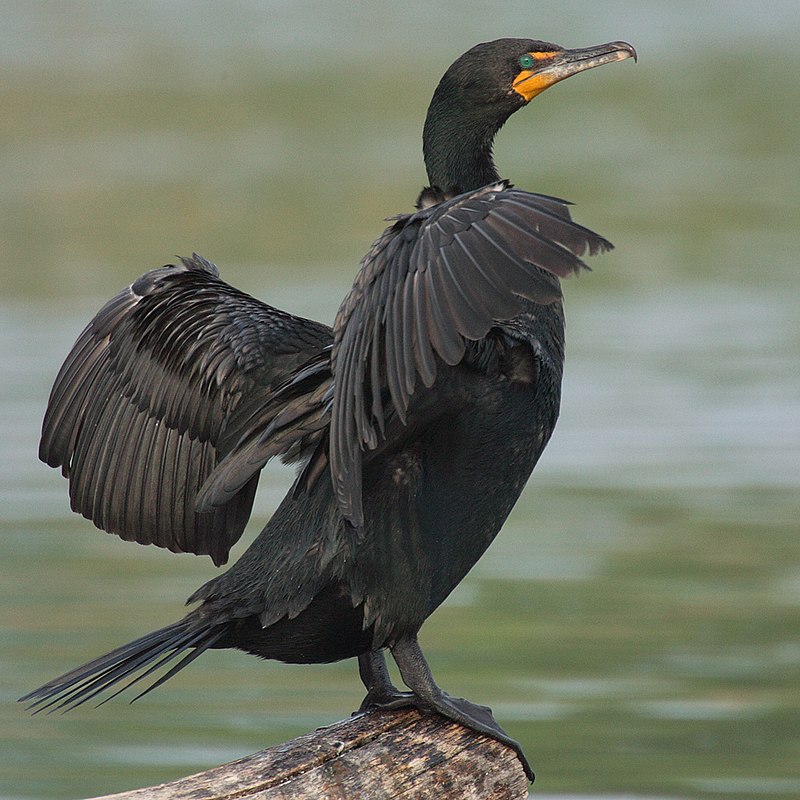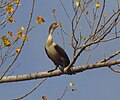
Taxonomy
The double-crested cormorant was described by Rene Primevere Lesson in 1831. Its scientific name is derived from the Greek words φαλακρος (phalakros), "bald" and κοραξ (korax), "crow" or "raven", and the Latin auritus, "eared", referring to its nuptial crests.[2] Its common name refers to the same nuptial crests.Five subspecies are recognized:[3]
- P. a. albociliatus (Ridgway 1884), Farallon cormorant,[4] breeds along the Pacific coast of North America from British Columbia to Bird Island in the state of Sinaloa, Mexico and possibly even further south. Significant colonies of these birds may also be found further inland including areas around the Salton Sea. According to currently available information, this subspecies is the third largest among the subspecies of the double-crested cormorant. Historical records indicate that this species was far more abundant in the past, but due to human persecution and development in their breeding range, the population of this subspecies has declined. The largest colony of cormorants in North America consisted of members of this subspecies at San Martin Island, Baja California Territory, Mexico, and was recorded in 1913.[3] Physically, this subspecies is fairly large and has white to partially white nuptial crests.[5]
- P. a. auritus (Lesson, 1831), the nominate subspecies, has the largest and most widespread breeding population. It ranges from the Great Basin and Rocky Mountains east into central and eastern North America. This region includes the Canadian prairies and the Great Lakes. Historically, this subspecies has bred in abundance across most of this region, though there are questions as to whether this bird has always bred in the Great Lakes region. Some evidence indicates that the bird has only begun breeding in the region since the early 20th century while other evidence suggests that it has been breeding in the region much longer. Physically, this subspecies is moderately large and has black nuptial crests.[3][5]
- P. a. cincinnatus (Brandt 1837), white-crested cormorant,[4] currently this is the most geographically restricted subspecies with the smallest population. It is found along the southern coast of Alaska and on the Aleutian Islands, ranging west from Kodiak to Chuginidak in the Aleutians. Historically, the range extended west to the Near Islands, but possibly due to nest predation by introduced foxes, the birds were no longer breeding in the area by the mid-1930s.[3] Physically, this subspecies is the largest and it bears straight, white nuptial crests.[5]
- P. a. floridanus (Audubon 1835), Florida cormorant,[4] the smallest of the five subspecies, it is found from southern and central Texas east to the Atlantic and from North Carolina south to Florida. Records indicate that this subspecies was abundant throughout its range before the 20th century, but now is only abundant in Florida. This bird has dark nuptial crests.[3]
- P. a. heuretus This subspecies bears straight, white nuptial crests.[5] Physically, it is the smallest. It has bare lores and a greenish gloss on the head and neck. It breeds only in the mangroves surrounding interior lakes of San Salvador in the Bahamas. It may also be resident on other Bahamian islands.[6]
Description
Adult in breeding plumage with white crests
This species has dark-colored plumage with bare supra-loreal skin and gular skin that is yellow or orange. An adult in breeding plumage will be mostly black with the back and coverts being a dark grayish towards the center. Nuptial crests, for which the species is named, are either white, black or a mix of the two. These are located just above the eyes with the bare skin on the face of a breeding adult being orange. A non-breeding adult will lack the crests and have more yellowish skin around the face. The bill of the adult is dark-colored.[5] The double-crested cormorant is very similar in appearance to the larger great cormorant, which has a more restricted distribution in North America, mainly on the Canadian maritime provinces; it can, however, be separated by having more yellow on the throat and the bill.[7]
The plumage of juvenile double-crested cormorants is more dark gray or brownish. The underparts of a juvenile are lighter than the back with a pale throat and breast that darkens towards the belly. As a bird ages, its plumage will grow darker. The bill of a juvenile will be mostly orange or yellowish.[5]
Distribution and habitat
A very common and widespread species, it winters anywhere that is ice-free along both coasts, as far north as southern Alaska (on the west coast) and southern New England (on the east coast). It can be found as far south as Mexico and the Bahamas. It migrates from the coldest parts of its breeding range, such as eastern Canada, and has occurred in Europe as a very rare vagrant, for example in Great Britain, Ireland, and the Azores.Behavior
Displaying, California
Diet
With a fish
Breeding
Eggs, Collection Museum Wiesbaden
Parent and a chick at the nest
Recovery
The double-crested cormorant's numbers decreased in the 1960s due to the effects of DDT. Colonies have also been persecuted from time to time in areas where they are thought to compete with human fishing.Recently the population of double-crested cormorants has increased. Some studies have concluded that the recovery was allowed by the decrease of contaminants, particularly the discontinued use of DDT.[8] The population may have also increased because of aquaculture ponds in its southern wintering grounds. The ponds favor good over-winter survival and growth.
In 1894, Thomas McIlwraith in his book, Birds of Ontario, concludes his section on double-crested cormorants by saying: “When the young are sufficiently grown, they gather into immense flocks in unfrequented sections, and remain until the ice-lid has closed over their food supply, when they go away, not to return till the cover is lifted up in the spring.”
For populations nesting in the Great Lakes region, it is believed that the colonization of the lakes by the non-native alewife (a small prey fish) has provided optimal feeding conditions and hence good breeding success. Double-crested cormorants eat other species of fish besides alewives and have been implicated in the decline of some sport-fish populations in the Great Lakes and other areas.[citation needed] Scientists[who?] are not in agreement about the exact extent of the role of cormorants in these declines, but some believe that double-crested cormorants may be a factor for some populations and in some locations.
In light of this belief, and because of calls for action by the public, the United States Fish and Wildlife Service (the U.S. federal government agency charged with their protection) has recently extended control options to some other government entities. This includes culling of populations and measures to thwart reproduction, in an effort to control their growing numbers. The U.S. Fish and Wildlife Service retains oversight and the control measures are not extended to the general public (no hunting season).[citation needed]
In May 2008, the Canadian government reduced significantly the number of nests of the birds on Middle Island, a small island in Lake Erie and part of Point Pelee National Park.[9] This is an attempt to keep the small island in balance and preserve its vegetation[10] but opponents to the plan have argued that it is based on faulty information, provided in part by anglers who view cormorants as competitors.[11]
Gallery
- Ballard (Hiram M. Chittenden) Locks, (Seattle, Washington).
Phalacrocorax auritus
(Lesson, 1831)

Geographical distribution of Double-crested cormorant. Breeding Migration Year-round Nonbreeding










No comments:
Post a Comment
Note: Only a member of this blog may post a comment.